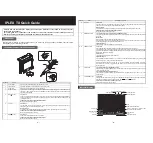
UNAOHM
44
EP2500 (Rev. 0)
The tuning frequency, its related channel, if available, and the current program are shown on next line
down.
•
SYMB
and the Symbol rate.
•
Next line down we find
MOD
and the type of constellation set, or the indication AUTO. On the
same line
M
is shown followed by the attenuation engaged.
•
On the bottom line
SPECT
and the polarity set is shown, or AUTO.
Figure 21
Typical QAM BER & MER display
9.1.6
How to Use the QAM Card
Program the frequency as for a normal analogue channel.
To initiate QAM operations press
MORE
,
DCP
and
BER
if you are in
MEA
suring mode, or press
DIGITAL (35)
, then
BER
if you are on
SPECT
rum , spectrum
EXP
anded or
TV
mode
For the module to function properly, the PWR index reading (see Figure 21) must read “OK”. If
necessary, use the attenuator engaging the lowest attenuation step which guarantees the “OK” reading.
Modulation and spectrum are automatically set.
The Symbol Rate can be set as follows:
PRMT
.
SYMB
.
Shaft encoder and, if necessary, and to set the value.
BACK
to terminate.
While the OFDM card is operating it is possible to change the tuning frequency as in the case of the
UHF band in analogue, but keep in mind the fact that the response time of the instrument in the digital
mode is longer. When storing a program, Symbol Rate, Modulation and Spectrum Polarity will be
stored as well together with the other typical parameters such as such frequency, etc. by means of the
key
↓↓
STORE (30)
.
To exit the OFDM function press
BACK
, then
EXIT
. See APPENDIX B for more details.
CH BER: 2.23 E -7 LOCKED
RU : 00000 (00h20m03s)
MER: 28.7 dB
CFO: 1.02 PWR index: OK
599.25 CH 37 PR02
SYMB :06875
MOD : 64QAM M00
SPECT: INVERTED
BACK
PRMT
SPECT
















































